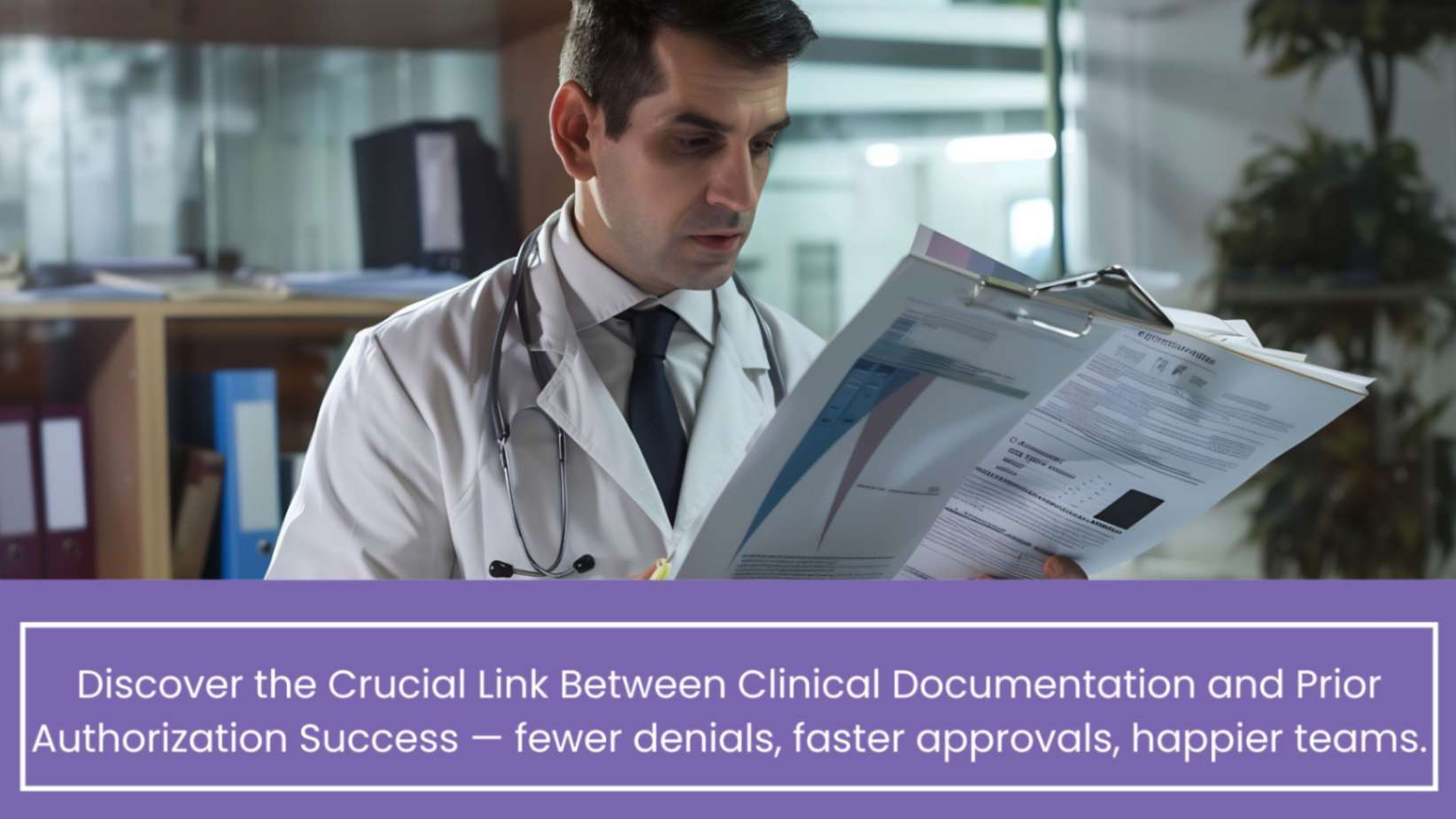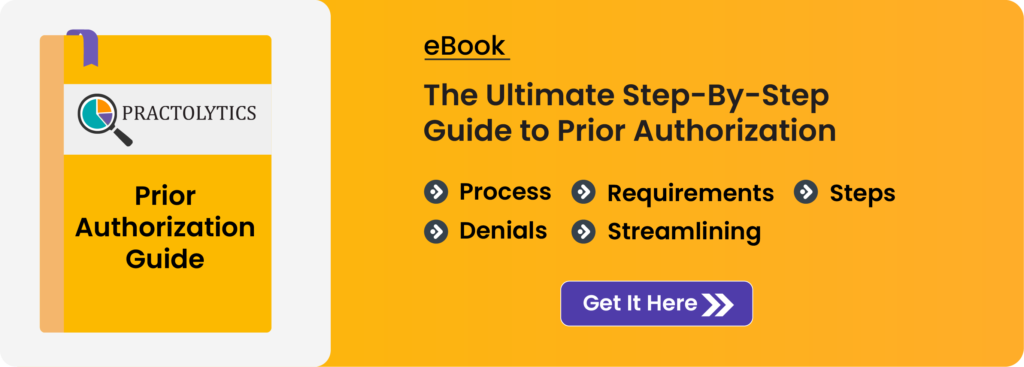Crucial Link Between Clinical Documentation and Prior Authorization Success
At Practolytics, we believe the Crucial Link Between Clinical Documentation and Prior Authorization Success transforms how practices navigate approvals. When your clinical notes are proactive, clear and aligned with payer requirements, you move from chasing denials to achieving first-pass wins. In today’s fast-paced healthcare landscape, that documentation isn’t just paperwork — it’s your frontline strategy. We’re here to help you close documentation gaps, create robust clinical note templates for prior authorizations, and design workflows that boost efficiency, accuracy and outcomes. Join us as we explore how you can harness this crucial link to reduce frustration, accelerate turnaround times and elevate patient care.
In the busy world of medical billing and regulatory requirements, there’s one relationship that often determines whether a service gets approved or denied: the Crucial Link Between Clinical Documentation and Prior Authorization Success. At Practolytics, we’ve seen time and again that when clinical teams invest in strong documentation practices — from initial clinical assessments to EMR templates that reflect payer medical-necessity checklists — the chances of getting prior authorization (PA) approved improve dramatically. On the flip side, weak or incomplete documentation leads to denials and delayed patient care. In this piece, we’ll walk you through why documentation defines PA outcomes, explore the state of PA in 2025, identify common documentation gaps, and explain how robust clinical documentation boosts those approval rates. Let’s dive in.
Table of Contents
Why Documentation Defines Prior Authorization Outcomes?
The scene is simple: a provider submits a PA request, the payer reviews it, and one of the biggest decision-drivers is what the clinical documentation shows. That means your clinical documentation for prior authorization must clearly demonstrate the medical necessity, relevant background, diagnostic reasoning, and proposed treatment plan. Without that, the request becomes vulnerable to objections such as “insufficient information,” “lack of medical necessity,” or “documentation does not support procedure.”
When you think about documentation, best practices, prior authorization, you’re really thinking about aligning the clinical narrative, diagnostic evidence, and payer criteria so that everything speaks the same language. If your notes don’t tie directly into the payer’s medical-necessity framework, you’re increasing the risk of a denial or needing to submit additional information — which drags out the prior authorization turnaround time and documentation quality equation.
And when denials happen, many trace back to documentation gaps rather than lack of clinical indication. So bottom line: strong documentation isn’t optional; it’s pivotal.
State of Prior Authorization in 2025
In 2025, prior authorizations remain a critical step in many specialties and treatment pathways. Payers are still increasing their oversight of high-cost procedures, specialty drugs, imaging, and elective interventions. As a result, the pressure on providers to demonstrate the case — often with more documentation and faster turnaround — has never been higher.
Couple that with increased scrutiny of outcomes, the rise of value-based care models, and growing payer analytics, and it becomes clear that documentation has to evolve, not just exist. Practices must now focus on metrics like first-pass approval rate prior authorization documentation and reduce the frequency of prior authorization denial due to documentation.
Modern EMRs and workflow tools are helping, but there’s still a gap: many providers are submitting PA requests that don’t reflect a standardized clinic note or checklist tailored for payer medical necessity. That means practices that don’t adapt risk falling behind, facing slower responses, more calls from payers, and frustrated staff and patients.
Understanding the Documentation-Prior Authorization Link
When we talk about the Crucial Link Between Clinical Documentation and Prior Authorization Success, what we’re really describing is the chain that connects:
- The provider’s initial evaluation and documentation (history, examination, diagnostics)
- The identified indication and justification for the requested procedure or service
- The alignment of that justification with the payer’s medical-necessity criteria (e.g., what constitutes “reasonable and necessary”)
- The workflow that packages this documentation into the PA submission, including any required forms, letters, imaging, lab results, or supporting clinical notes
- The payer’s review process, which looks not only at clinical indication but also at the documentation sufficiency and clarity
- The decision (approval or denial) — and if it’s approved, how the documentation supports the subsequent claim submission
If any link in that chain is weak, especially the documentation leg, you risk increasing the prior authorization turnaround time and documentation quality problem, as well as decreasing your first-pass approval rate prior authorization documentation.
From our experience at Practolytics, we’ve seen that standardized documentation templates, built into the EMR workflow, significantly reduce the time staff spend gathering information and submitting PA requests — and reduce documentation-related denials. A key phrase here: standardized documentation and prior authorization success. When your practice builds a repeatable and reliable documentation process, you cut down on “somehow forgot to include the MRI report” or “provider note did not include symptoms and duration” issues.
It’s easier said than done, but the link is clear: strong documentation → smoother PA submission → higher approval rates → reduced administrative burden → better patient experience.
Common Documentation Gaps Affecting Prior Authorization
Let’s talk about some of the most frequent documentation issues that undermine Outsourcing Prior Authorization success:
- Missing or vague indication for treatment: When the clinical note doesn’t clearly state why the service is medically necessary, the payer may view it as elective. This is one of the top reasons for prior authorization denial due to documentation.
- Lack of prior conservative therapy or failure history: Many payer criteria require that less invasive options were tried and shown ineffective — if your documentation doesn’t include that, you’ve left a gap.
- Incomplete patient history or exam: Payers want enough context — duration of symptoms, severity, prior treatments, functional limitations. Without it, the justification feels thin.
- No clear diagnostic evidence: Imaging, lab work, or other objective findings must often be included. If omitted, the request may be challenged.
- Poor linkage between service requested and documentation: If the plan calls for “procedure X,” but the note doesn’t explain how and why procedure X fits the patient’s condition, you’ve lost alignment.
- Inconsistent template usage: Practice staff may use different documentation templates, leading to missing fields or inconsistent language. That reduces the efficiency of capturing payer-friendly information.
- EMR workflow barriers: If your documentation process isn’t built with PA in mind (for example, forcing staff to gather evidence post-visit or manually search for past conservative treatments), your turnaround slows and errors increase.
- Lack of standard checklist for payer medical necessity: Without a built-in payer medical necessity documentation checklist, the likelihood of missing required info grows.
These gaps all feed into the broader problem of documentation gaps affecting prior authorization outcomes. If you’re not actively managing and measuring them, they will continue to drag on your practice efficiency and finances.
How Robust Clinical Documentation Improves Prior Authorization Success?
Now for the good news: you can change the outcome. Here’s how we at Practolytics help practices build documentation workflows that link directly to PA success.
1. Build and adopt clinical note templates for prior authorizations
By standardizing the template that captures history, exam, diagnostics, conservative treatment, the indication for the requested service, risks/benefits and functional impact, you embed best-practice documentation at the point of care. A repeatable template means fewer missing fields, less ambiguity, and faster submission.
2. Align documentation with payer criteria (medical-necessity language)
Using a payer medical necessity documentation checklist, you ensure each request hits the key elements a reviewer expects. That might mean explicitly documenting “failed physical therapy for 12 weeks,” or “imaging shows moderate degeneration with neural compromise, correlating with patient symptoms.”
3. Use EMR workflows to integrate the PA process
When your EMR prompts for specific fields (for example: “Has the patient attempted conservative therapy? Y/N — If yes, date”), you reduce reliance on memory and reduce the risk of missing data. This addresses EMR workflows documentation for prior authorizations directly. It speeds up the documentation, keeps it consistent, and reduces downstream queries from payers.
4. Close documentation gaps quickly and definitively
If a PA request comes back with a “needs additional information” request, your chance of faster approval declines. By proactively identifying likely gaps (such as missing imaging, missing prior therapy attempts, missing functional limitations) and gathering that documentation before submission, you improve your first-pass approval rate prior authorization documentation. Fewer rounds of back-and-forth means less delay, less administrative cost, and better patient experience.
5. Monitor and measure documentation-driven metrics
Track metrics like: what percentage of PAs are approved on first submission? How many are denied citing “insufficient documentation”? What’s the average turnaround time from submission to approval? These metrics help you pinpoint where your documentation process needs tightening. By focusing on improving prior authorization approval through documentation, you are turning documentation into a strategic lever, not an administrative after-thought.
6. Improve turnaround time and reduce workflow friction
When your documentation is comprehensive and aligned with payer expectations, your prior authorization turnaround time and documentation quality both improve. That means your staff spends less time chasing missing info, patients wait less, and you reduce the likelihood of services being delayed or cancelled due to authorization issues.
At Practolytics, we partner with practices to implement documentation process enhancements, standardized templates, automated tracking and the backend support to make this documentation Healthcare Prior Authorization link real and effective. Ultimately, this helps you spend less time on administrative burdens and more on patient care.
Conclusion:
The Crucial Link Between Clinical Documentation and Prior Authorization Success is more than a catch-phrase — it’s a practice-transforming reality. When you build documentation workflows that align with payer criteria, proactively fill all required fields, and monitor your metrics, you improve your first-pass approval rates, reduce denials due to Prior authorization denial due to documentation, and strengthen your practice’s operational efficiency. At Practolytics, we’re committed to helping you bridge that gap — because better documentation means smoother authorizations, less stress, and superior patient care.
Why is prior authorization (PA) so common now, and how does it affect my practice?
Prior authorization is common because payers are increasingly managing costs and ensuring medical necessity. It affects your practice by introducing an additional step before delivering services, which can delay care, add administrative burden, and increase the risk of non-payment or denial if documentation is incomplete.
What is the single most important element of my clinical documentation for a successful prior authorization?
The most important element is a clear — and payer-aligned — statement of medical necessity that links the patient’s condition, prior treatments, diagnostic evidence, and the requested service. Without that, the request becomes vulnerable.
What is the main reason prior authorizations for medically necessary services are denied?
The main reason is inadequate or missing documentation: the clinical note fails to show the required history, conservative treatment attempts, diagnostic evidence or functional impairment — in other words, the documentation doesn’t support the clinical justification.
What key information must be included in my patient note to support a prior authorization request for a procedure?
You must include: patient’s presenting problem (symptoms and duration), relevant exam/diagnostic results (imaging, labs), prior conservative interventions and their outcomes, functional limitations, the proposed treatment/service and rationale, and how the service meets payer medical-necessity criteria.
If a payer denies a PA based on lack of documentation, what’s my best first step for appeal?
Your best first step is to gather and organize the missing documentation (e.g., updated note, imaging report, therapy summary) then submit a documented appeal letter referencing the payer criteria and linking the data to the requested service. Also review your internal documentation workflow to prevent recurrence.
Read More – Prior Authorization Services for Podiatry : improving Patient Access and Care
Talk to Medical Billing Expert Today — Get a Free Demo Now!






